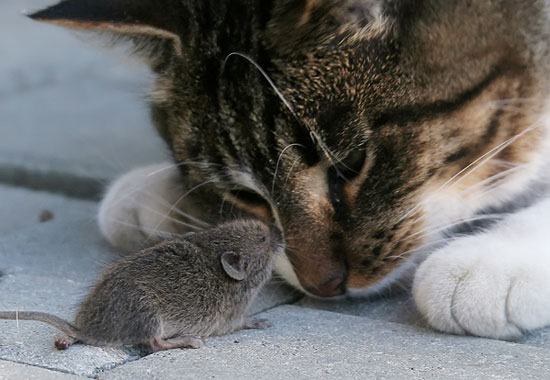Parasites make mice like cats
Scientists have discovered that a parasite can turn mice into "zombies" and cause them to lose their fears of a "sworn enemy" as a cat.
Cat urine often acts as a warning sign that rats must stay away from predators in nature. However, US researchers found that male mice infected with the Toxoplasma parasite, when exposed to cat urine, were increasingly stimulated in brain regions associated with sexual attraction. At the same time, the brain regions dominate the fear of paralysis.
The Daily Mail quoted Robert Sapolsky, a professor of neurology at Stanford University in the United States, and co-author of the study, saying: "Normally, we wait for Toxoplasma to neutralize the function of causing panic. usually in the brain, but in male mice infected with Toxoplasma, this parasite also interferes with the aphrodisiac pathway.

Toxoplasma is a type of unicellular parasite that only lives in cells, parasites in humans and some species of birds and animals. Toxoplasma requires a cat's digestive system - their main host - to reproduce. Up to one third of human tests are positive for Toxoplasma, mainly due to eating undercooked meat or contact with cat feces. In humans, exposure to Toxoplasma is especially dangerous for developing fetuses and pregnant women.
Through the ability to reduce the fear of rats for cats' scent and to make rodents see attractive predators, this parasite has increased the likelihood of rats being killed by cats. And that helps to improve the life cycle of Toxoplasma parasites.
Patrick House - a doctoral student at Stanford University and also a key member of the research team, stated: "Our findings reinforce the notion that, in mice, Toxoplasma has changed status. The characteristic emotion of finding cats is that they also show that fear and attraction can lie on the same spectrum, or at least the process of handling fearful and attractive emotional states is completely unrelated to each other ".
Scientists believe their findings may help explain the biological bases of innate fear and sexual attraction .
- Mice no longer fear cats when infected with parasites
- Fearful cats flee the mouse on the street
- The 'strange' cats in the world
- It turned out not to keep cats as mice
- Rats respond to panic cat regress
- Why do cats like to quit 'booty' home?
- Watch out for deadly parasite infections from cats
- Why are mice afraid of cats?
- Rodents are like cats
- The mole rats eat the mouse rat manure to get instructions for raising children
- 9 truths 'cause sock' dedicated to cat lovers
- Horror parasites make bees to dig their own burial holes
 Why do potatoes have eyes?
Why do potatoes have eyes? 'Tragedy' the world's largest carnivorous life: Death becomes ... public toilet
'Tragedy' the world's largest carnivorous life: Death becomes ... public toilet Tomatoes were once considered 'poisonous' for 200 years
Tomatoes were once considered 'poisonous' for 200 years Detecting microscopic parasites on human face
Detecting microscopic parasites on human face